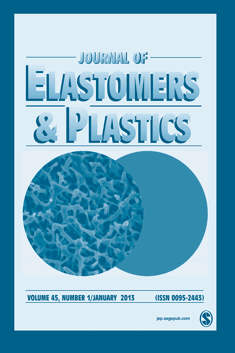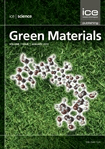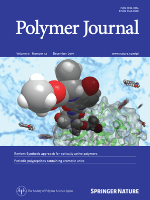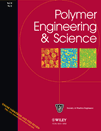
JOURNAL OF ELASTOMERS AND PLASTICS
Scope & Guideline
Championing Excellence in Material Science Research
Introduction
Aims and Scopes
- Material Characterization and Properties:
The journal emphasizes the characterization of elastomers and plastics, including their mechanical, thermal, and electrical properties, often utilizing advanced techniques such as rheology, TGA, and DSC. - Nanocomposite Development:
A significant focus is placed on the development and analysis of nanocomposites, integrating nanoparticles or other fillers to enhance mechanical and thermal properties of traditional elastomers and plastics. - Innovative Processing Techniques:
Research on novel processing methods, including additive manufacturing and various compounding techniques, is a core area, highlighting how processing affects material performance. - Sustainable and Biocomposite Materials:
There is a growing interest in eco-friendly materials, including biocomposites and the utilization of renewable resources, which reflects a commitment to sustainability in material science. - Application-Specific Studies:
The journal features studies that explore the application of elastomers and plastics in specific industries, such as automotive, aerospace, and biomedical fields, showcasing the practical relevance of the research.
Trending and Emerging
- Additive Manufacturing of Elastomers:
The trend towards 3D printing and additive manufacturing of elastomers is on the rise, with research exploring the unique properties and applications of printed elastomeric materials. - Smart and Functional Materials:
There is an increasing interest in developing smart elastomers and plastics that exhibit responsive behavior to external stimuli, which could lead to innovative applications in various fields. - Sustainable Materials and Green Chemistry:
Research exploring sustainable materials, including biobased and biodegradable composites, is trending as environmental concerns drive the need for greener alternatives in material science. - Advanced Nanocomposites with Multifunctionality:
The development of advanced nanocomposites that not only enhance mechanical properties but also provide additional functionalities, such as electrical conductivity or thermal stability, is becoming a prominent theme. - Hybrid Materials for Enhanced Performance:
Research on hybrid materials that combine different types of fillers or reinforcements to achieve superior properties is gaining popularity, showcasing the versatility of elastomers and plastics.
Declining or Waning
- Traditional Rubber Compounding:
Research centered around traditional rubber compounding techniques has seen a decrease, possibly due to the emergence of more advanced materials and processing methods that offer superior performance. - Conventional Thermoplastics without Nanofillers:
Studies focusing solely on conventional thermoplastics without the integration of nanofillers or innovative additives are becoming less common, indicating a shift towards more sophisticated material formulations. - Basic Mechanical Testing without Advanced Characterization:
There is a noted reduction in publications that focus solely on basic mechanical testing methods without accompanying advanced characterization techniques, as the field moves towards more comprehensive analyses.
Similar Journals

POLYMER INTERNATIONAL
Connecting Researchers to Cutting-edge Polymer InsightsPOLYMER INTERNATIONAL is a leading journal in the field of polymer science, published by Wiley, one of the most esteemed scholarly publishers. With an ISSN of 0959-8103 and an E-ISSN of 1097-0126, this journal has been a pivotal platform for researchers since its inception in 1991, now extending its coverage until 2024. The journal boasts a commendable standing in various scientific domains, achieving a Q2 quartile ranking in Materials Chemistry, Organic Chemistry, and Polymers and Plastics as of 2023. Additionally, it holds impressive Scopus ranks, including Rank #47 in Organic Chemistry and Rank #40 in Polymers and Plastics, placing it within the top percentiles of its categories. Researchers, professionals, and students alike can benefit from its rich array of articles that contribute to the understanding and advancement of polymer technology and materials science. Although not an open access journal, POLYMER INTERNATIONAL remains crucial for disseminating high-quality research that drives innovation and development within the field.

RUBBER CHEMISTRY AND TECHNOLOGY
Connecting Science and Technology in RubberRubber Chemistry and Technology is a distinguished journal published by the American Chemical Society, focusing on the vital field of rubber science and technology. With the ISSN 0035-9475 and an E-ISSN of 1943-4804, this journal has provided a platform for scholarly research since its inception in 1970, straddling a rich history of contributions in the area of materials science and polymers. In the most recent assessments, it holds a Q3 ranking in both Materials Chemistry and Polymers and Plastics, indicative of its growing influence and respect in the scientific community. Researchers and professionals benefit from a wide spectrum of topics, including the latest advancements in rubber formulations, processing technologies, and applications across various industries. Although it operates under a traditional subscription model, its commitment to high-quality, peer-reviewed research makes it an essential resource for anyone involved in the cutting-edge study of rubber as a material. Given its ongoing publication and relevance to the field, Rubber Chemistry and Technology remains a cornerstone for professionals and academics eager to explore innovative rubber technologies and their applications.

Green Materials
Transforming challenges into sustainable material solutions.Green Materials, published by Emerald Group Publishing Ltd, serves as a crucial platform for research within the realm of sustainable materials science. Since its inception in 2013, this journal has focused on addressing pressing global challenges, particularly in Materials Chemistry, Pollution, and Polymers and Plastics, as evidenced by its rankings within the Q3 Quartiles. With a commitment to high-quality, peer-reviewed content, it caters to an audience keen on innovative solutions that promote environmental sustainability. Researchers and professionals can access a wealth of knowledge and insights that are instrumental in advancing the field, despite the absence of an open-access option. As the journal continues to converge towards its projected endpoint in 2024, it remains a vital resource for those dedicated to exploring the intersection of materials science and ecological responsibility, ensuring its relevance in academic discussions and practical applications.

POLYMER JOURNAL
Elevating Knowledge in the World of PolymersPOLYMER JOURNAL, published by SpringerNature in the United Kingdom, is a premier academic platform dedicated to the field of polymer science. Since its inception in 1971, this journal has become an essential resource for researchers and professionals interested in the latest advancements in materials chemistry, polymers, and plastics. With its robust H-index and a consistent ranking in the top quartiles of its categories—Q2 in both Materials Chemistry and Polymers and Plastics—POLYMER JOURNAL demonstrates a strong impact in the scientific community. It holds significant recognition in Scopus rankings, occupying the 68th percentile in Materials Chemistry and the 67th percentile in Polymers and Plastics. The journal's commitment to publishing high-quality research articles enables it to serve as a key reference point for innovative studies, theoretical developments, and practical applications in polymer science. Although it is not an open-access journal, researchers and students gain valuable insights through its extensive archives and rigorous peer-reviewed content, making POLYMER JOURNAL a vital source of knowledge for anyone engaged in this dynamic field.

INTERNATIONAL POLYMER PROCESSING
Pioneering Research in the World of Polymers and PlasticsINTERNATIONAL POLYMER PROCESSING, published by WALTER DE GRUYTER GMBH, serves as a crucial platform for professionals and researchers in the fields of Chemical Engineering, Industrial and Manufacturing Engineering, and Materials Science, particularly focusing on polymers and plastics. With its ISSN 0930-777X and E-ISSN 2195-8602, this journal has been in circulation since 1988 and continues to expand its contributions to contemporary research trends through to 2024. Ranking in the third quartile across multiple categories, including Chemical Engineering (miscellaneous) and Materials Chemistry, it offers insightful and rigorous peer-reviewed articles that enhance the understanding of polymer processing technologies and innovations. This journal is vital for anyone engaged in polymer science and engineering, providing both theoretical and practical perspectives that advance the field. Although it does not provide open access, the journal's content is indispensable for academia and industry professionals looking to stay at the forefront of polymer research.

POLYMERS & POLYMER COMPOSITES
Fostering Collaboration in Material AdvancementsPOLYMERS & POLYMER COMPOSITES, published by SAGE Publications Ltd, is a prestigious journal dedicated to the exploration of significant advancements in the diverse fields of polymers, composite materials, and their innovative applications. With an ISSN of 0967-3911 and E-ISSN of 1478-2391, this journal plays a crucial role in the academic community, boasting an impressive ranking in the Q2 quartile across pivotal categories such as Ceramics and Composites, Materials Chemistry, and Polymers and Plastics in 2023. Positioned in the United Kingdom, it serves as a vital resource for researchers and professionals, providing insights into current trends and future directions in material science. Despite its availability not extending to Open Access, the journal aims to promote rigorous peer-reviewed research, thus fostering knowledge and collaboration among scholars. With publication convergence from 1993 to 2024, POLYMERS & POLYMER COMPOSITES stands as a cornerstone for those pursuing advanced understanding and excellence in material innovation.

POLYMER ENGINEERING AND SCIENCE
Unveiling Innovations in Polymer EngineeringPOLYMER ENGINEERING AND SCIENCE, published by WILEY, is a premier journal specializing in the field of polymer science and engineering. Since its inception in 1961, this journal has been at the forefront of disseminating high-quality research, focusing on various aspects of polymers and plastics, including their chemistry, properties, and applications. With an impressive impact factor, it ranks in the second quartile (Q2) across multiple categories, including Chemistry (Miscellaneous), Materials Chemistry, and Polymers and Plastics, showcasing the journal's significance and influence in these vital areas of research. Researchers and professionals in academia and industry will find the latest advancements and innovative methodologies in polymer science, making this journal an essential resource for those looking to stay updated on cutting-edge developments. While it does not currently support Open Access, its comprehensive scope and critical insights positioned it as a valuable platform for advancing knowledge and fostering collaboration within the polymer community. The journal’s office is located at 111 River St, Hoboken 07030-5774, NJ, United States, emphasizing its strong presence in the academic landscape.

Journal of Polymer & Composites
Pioneering Research at the Intersection of Polymers and Composites.Journal of Polymer & Composites, with ISSN 2321-8525 and E-ISSN 2321-2810, is an esteemed academic journal published by STM JOURNALS, dedicated to the advancement of knowledge in the rapidly evolving fields of polymer science and composite materials. The journal serves as a pivotal platform for researchers and professionals, offering cutting-edge research articles, reviews, and case studies that explore innovative developments and applications in polymer chemistry, material science, and engineering. Although currently lacking an impact factor citation, the journal aims to foster dialogue among academia and industry partners, addressing the latest trends and breakthroughs that drive the field forward. With a commitment to scholarly excellence, the Journal of Polymer & Composites is positioned as an essential resource for enhancing the understanding of polymer composites and their multifaceted applications. Notably, STM JOURNALS' reputation for quality publications underscores the journal’s importance in facilitating impactful research and educational initiatives worldwide.

ACTA POLYMERICA SINICA
Elevating Knowledge in Chemical Engineering and Polymer ResearchACTA POLYMERICA SINICA is a distinguished journal published by SCIENCE PRESS, specializing in the multifaceted disciplines of Chemical Engineering, Chemistry, and Polymers and Plastics. Established in 1996, this peer-reviewed journal provides a critical platform for the dissemination of cutting-edge research and advancements within these fields, promoting innovation and knowledge-sharing among researchers and professionals globally. With its presence in the highly competitive Q3 quartile rankings as of 2023, the journal demonstrates a commitment to maintaining rigorous academic standards while supporting the evolving landscape of polymer science. Operating from Beijing, China, the journal caters to a broad readership and emphasizes the importance of interdisciplinary collaboration in addressing contemporary challenges in material science. Although it does not offer open access, ACTA POLYMERICA SINICA remains a vital resource for scholars seeking to enhance their understanding and contribute valuable insights to the field.

MACROMOLECULAR RESEARCH
Connecting Researchers in the World of PolymersMACROMOLECULAR RESEARCH, published by the POLYMER SOC KOREA, is a premier journal dedicated to advancing the field of macromolecular science and polymer engineering. With its ISSN 1598-5032 and E-ISSN 2092-7673, this journal has emerged as a vital platform for researchers and professionals interested in the application and development of polymers across various domains. Based in South Korea and operating as an open-access resource since its inception in 2002, MACROMOLECULAR RESEARCH consistently ranks in the Q2 category across diverse fields such as Chemical Engineering, Materials Chemistry, and Organic Chemistry as per the latest 2023 metrics. Notably, it is recognized for its substantial contributions to polymery science, increasing its visibility and impact in global research. By providing a forum for original research articles, reviews, and innovative methodologies, this journal aims to foster collaboration and knowledge sharing among scientists, engineers, and students alike. Join a community that is at the forefront of polymer research by exploring the wealth of resources and cutting-edge studies featured in MACROMOLECULAR RESEARCH.